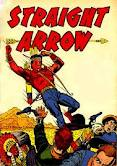Straight Arrow
 Straight Arrow was a kids’ series that featured exciting western adventures. It was launched by the West Coast Don Lee Network on May 6, 1948 and had a three year run, ending on June 21, 1951.
Straight Arrow was a kids’ series that featured exciting western adventures. It was launched by the West Coast Don Lee Network on May 6, 1948 and had a three year run, ending on June 21, 1951.
Steve Adams, the rancher and owner of the Broken Bow cattle ranch, was played by Howard Culver. During trying times on the ranch, Steve became “Straight Arrow,” a fierce Comanche warrior.
No one knew Adams’ true identity with the exception of Packy McCloud, played by Fred Howard. McCloud was the contrary ranch hand who joined Adams as his sidekick. “Mesquite Molly” was the name of the ranch’s housekeeper, played by Gwen Delano.
Narrator and announcer of Straight Arrow was Frank Bingman, followed by Eddy Weet. Sheldon Stark, who formerly wrote scripts for The Green Hornet and Challenge of the Yukon, wrote the scripts for all 292 shows.
Straight Arrow hid his disguise in a secret cave, including a beautiful, golden colored palomino stallion (named Fury), which he’d ride, thundering out of the cave in full Indian dress on his way to save his people and those who needed his help.
Amazing sound effects were put into place to promote the Straight Arrow series. When Straight Arrow yelled his Comanche war cry, “Kaneewah, Fury!” the sound boomed out of an echo chamber, adding a fearsome effect.
Adams also provided sound effects when he would change his normal voice to a low, intimidating voice as he transformed from Adams to Straight Arrow. He also used dialogue that sounded like authentic Indian words.
The reason that the sound effects were so authentic was because soundman, Ray Kemper visited Gallup, New Mexico, and attended (and recorded) ceremonial Indian gatherings. He was then able to capture the sounds and relay them to the show.
Milton Chase deserves praise for his part of the sound effects, simulating the arrow’s flight that sounded at the beginning of the show. You could hear the bow snap and hear the arrow fly.
The sound of the arrow ended when the listener heard the thud of the arrow as it found its mark. The sound was produced on a Hammond organ and had the effect of making shivers tingle down your spine.
Sound effects and attention-catching dialogue were the reasons for the success of Straight Arrow. Long after the show went off the air, a Straight Arrow newsletter was a popular source of information for fans.
The newsletter was created by William and Teresa Harper of Augusta, South Carolina and only ended in the 1990s. The newsletter was extremely well done and was considered a go-to source for any information pertaining to the radio series, Straight Arrow.
We have several episodes of Straight Arrow, which I will add over the following week.
Happy listening my friends,
